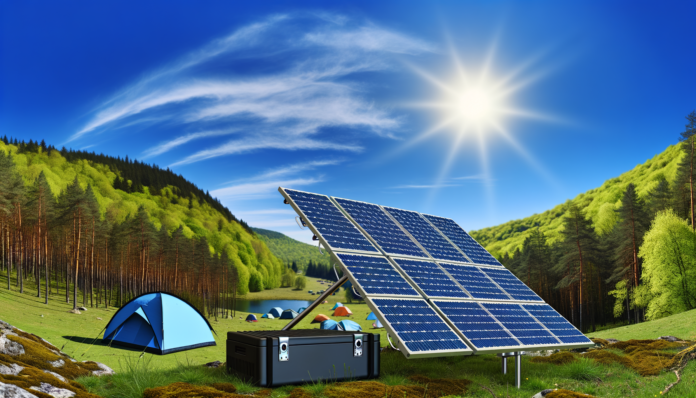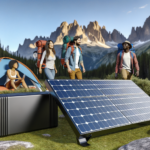Introduction
The Growing Popularity of Solar Power
In recent years, solar power has surged in popularity as a sustainable and eco-friendly energy solution. With advancements in technology and a growing awareness of environmental issues, more individuals and organizations are turning to solar energy to meet their power needs. Solar power is not only renewable but also reduces our reliance on fossil fuels, thereby decreasing greenhouse gas emissions. This shift towards solar energy is evident in various sectors, from residential homes to large-scale industrial applications, and is now making significant inroads into the realm of outdoor expeditions and adventures.
Why Solar Storage is Essential for Expeditions
For outdoor enthusiasts, adventurers, and expedition teams, reliable power sources are crucial. Whether you’re camping in the wilderness, hiking remote trails, or embarking on a boating trip, having access to electricity can enhance your experience and ensure safety. This is where solar storage comes into play. Solar storage solutions allow you to harness the sun’s energy during the day and store it for use when you need it most, such as during the night or on cloudy days. This capability is essential for powering a range of devices, from GPS units and smartphones to cooking equipment and emergency lights. Moreover, solar storage systems are often portable, making them ideal for expeditions where traditional power sources are unavailable.
Purpose and Scope of the Article
The purpose of this article is to provide a comprehensive guide on innovative solar storage solutions for your next expedition. We will explore the various types of solar storage technologies available, their benefits, and how to choose the right system for your specific needs. Additionally, we will offer practical tips on setting up and maintaining your solar storage system to maximize its efficiency. Through real-world case studies, we will illustrate the diverse applications of solar storage in different expedition scenarios, from camping and hiking to boating and emergency preparedness. By the end of this article, you will have a thorough understanding of how to effectively integrate solar storage into your outdoor adventures, ensuring a reliable and sustainable power supply wherever your journey takes you.
Understanding Solar Storage
What is Solar Storage?
Solar storage refers to the technology and systems used to store energy generated from solar panels. This stored energy can then be used at a later time when sunlight is not available, such as during nighttime or cloudy days. The primary components of a solar storage system include solar panels, batteries, inverters, and charge controllers. Solar panels convert sunlight into electricity, which is then stored in batteries. Inverters convert the stored direct current (DC) electricity into alternating current (AC) electricity, which is used by most electronic devices. Charge controllers regulate the flow of electricity to and from the batteries, ensuring they are charged efficiently and safely.
Types of Solar Storage Solutions
There are several types of solar storage solutions available, each with its own advantages and applications:
- Lead-Acid Batteries: These are the most traditional and widely used type of batteries for solar storage. They are relatively inexpensive but have a shorter lifespan and lower energy density compared to newer technologies.
- Lithium-Ion Batteries: Known for their high energy density, long lifespan, and lightweight design, lithium-ion batteries are becoming increasingly popular for solar storage. They are more expensive than lead-acid batteries but offer better performance and efficiency.
- Flow Batteries: These batteries use liquid electrolytes to store energy and are known for their long cycle life and scalability. They are ideal for large-scale solar storage applications but are less common for personal use due to their complexity and cost.
- Solar Generators: These are portable units that combine solar panels, batteries, and inverters into a single system. They are ideal for outdoor enthusiasts who need a compact and portable power solution for their expeditions.
Benefits of Solar Storage for Outdoor Enthusiasts
Solar storage offers numerous benefits for outdoor enthusiasts, making it an essential component for any expedition:
- Reliability: Solar storage systems provide a reliable source of power, ensuring that essential devices such as GPS units, smartphones, and cameras remain charged and operational, even in remote locations.
- Portability: Modern solar storage solutions are designed to be lightweight and portable, making them easy to carry and set up during outdoor adventures. This is particularly important for activities like hiking, camping, and boating.
- Environmental Impact: Using solar power reduces the reliance on fossil fuels and minimizes the environmental impact of outdoor activities. Solar storage systems harness renewable energy, making them an eco-friendly choice.
- Cost-Effectiveness: While the initial investment in solar storage systems can be high, they offer long-term savings by reducing the need for disposable batteries and fuel for generators. Over time, the cost of solar storage can be offset by the savings on energy expenses.
- Emergency Preparedness: Solar storage systems can be a critical component of emergency preparedness kits. They provide a dependable source of power during natural disasters or unexpected situations, ensuring that communication devices and emergency equipment remain functional.
In summary, understanding solar storage and its various solutions is crucial for anyone planning an outdoor expedition. The right solar storage system can enhance the overall experience by providing reliable, portable, and eco-friendly power, ensuring that adventurers are well-prepared for any situation.
Innovative Solar Storage Technologies
Portable Solar Panels
Portable solar panels are a game-changer for outdoor enthusiasts. These lightweight, foldable panels can be easily packed and carried, making them ideal for camping, hiking, and other outdoor activities. They can be set up quickly to capture sunlight and convert it into electricity, which can then be used to charge devices like smartphones, GPS units, and portable lights. **Key benefits** include their portability, ease of use, and the ability to generate power in remote locations where traditional power sources are unavailable.
Solar Generators
Solar generators are compact, all-in-one units that combine solar panels, a battery, and an inverter. They are designed to store solar energy and provide a reliable power source for various devices and appliances. **Advantages** of solar generators include their ability to provide a consistent power supply, even during cloudy days or at night, thanks to their built-in battery storage. They are perfect for longer expeditions, RV trips, and emergency situations where a dependable power source is crucial.
Solar-Powered Batteries
Solar-powered batteries are another innovative solution for storing solar energy. These batteries can be charged using portable solar panels and then used to power a wide range of devices. They come in various sizes and capacities, making them suitable for different needs, from charging small gadgets to running larger appliances. **Benefits** of solar-powered batteries include their versatility, ability to store energy for later use, and the convenience of having a portable power source that can be recharged using the sun.
Hybrid Solar Systems
Hybrid solar systems combine multiple solar storage technologies to create a more versatile and efficient power solution. These systems typically include a combination of portable solar panels, solar generators, and solar-powered batteries. By integrating different components, hybrid systems can provide a more reliable and flexible power source for various applications. **Key features** of hybrid solar systems include their ability to optimize energy capture and storage, adaptability to different power needs, and enhanced reliability in diverse conditions.
In summary, innovative solar storage technologies like portable solar panels, solar generators, solar-powered batteries, and hybrid solar systems offer a range of solutions to meet the power needs of outdoor enthusiasts. These technologies provide the convenience of portable, renewable energy, making them essential for any expedition.
Choosing the Right Solar Storage for Your Expedition
Assessing Your Power Needs
Before embarking on your expedition, it’s crucial to determine your power requirements. Start by listing all the devices and equipment you’ll need to power, such as smartphones, GPS units, cameras, and portable refrigerators. Calculate the total watt-hours (Wh) required by adding up the power consumption of each device. This will help you choose a solar storage solution that can meet your energy demands. Remember, it’s always better to overestimate your needs to ensure you have enough power for unexpected situations.
Evaluating Portability and Durability
When selecting solar storage for an expedition, portability and durability are key factors. Look for lightweight and compact options that are easy to carry and set up. **Portable solar panels** and **solar-powered batteries** are excellent choices for their ease of transport. Additionally, ensure that the equipment is rugged and weather-resistant to withstand the harsh conditions you might encounter. Features like water resistance, dustproofing, and shockproofing can significantly enhance the longevity and reliability of your solar storage system.
Understanding Efficiency and Capacity
Efficiency and capacity are critical aspects to consider when choosing solar storage. The efficiency of solar panels and batteries determines how effectively they convert and store solar energy. Look for high-efficiency panels that can generate more power in less time. Similarly, opt for batteries with high energy density, which can store more power in a smaller space. **Solar generators** often combine both high-efficiency panels and high-capacity batteries, making them a versatile option for various expeditions.
Considering Cost and Value
While cost is always a consideration, it’s essential to evaluate the overall value of the solar storage solution. Compare the initial investment with the long-term benefits, such as reduced reliance on traditional power sources and lower operational costs. Look for products that offer a good balance between price, performance, and durability. Additionally, consider any available incentives or rebates for solar products, which can help offset the initial costs. Investing in a reliable and efficient solar storage system can provide significant value over time, especially for frequent adventurers.
By carefully assessing your power needs, evaluating portability and durability, understanding efficiency and capacity, and considering cost and value, you can choose the right solar storage solution for your next expedition. This will ensure you have a reliable and sustainable power source, allowing you to focus on enjoying your adventure.
Setting Up and Using Solar Storage
Installation Tips
Setting up solar storage for your expedition can be straightforward if you follow some essential tips. First, **choose a location** with maximum sun exposure. Whether you’re setting up portable solar panels or a solar generator, ensure they are positioned to capture the most sunlight throughout the day. **Angle the panels** correctly; a tilt angle equal to your latitude is generally recommended for optimal performance.
Next, **connect your devices** properly. Use the appropriate connectors and cables to link your solar panels to your storage units, such as batteries or generators. For instance, if your setup includes MC4 connectors, ensure they are securely fastened to avoid any power loss. **Secure your setup** to prevent it from being disturbed by wind or other environmental factors. Use tie-wraps or mounting brackets as needed.
Lastly, **test your system** before heading out. Make sure all components are functioning correctly and that your storage units are charging efficiently. This pre-trip check can save you from potential issues during your expedition.
Maintenance and Care
Proper maintenance and care are crucial for the longevity and efficiency of your solar storage system. **Regularly clean your solar panels** to remove dust, dirt, and debris that can obstruct sunlight. Use a soft cloth and mild detergent to avoid scratching the surface. **Inspect the connections** periodically to ensure they are tight and free from corrosion. Loose or corroded connections can lead to power loss and inefficiency.
**Monitor the battery health** of your storage units. Most solar-powered batteries come with indicators that show their charge status and health. If you notice any significant drop in performance, it might be time to replace the battery. **Store your equipment** properly when not in use. Keep solar panels and batteries in a dry, cool place to prevent damage from moisture and extreme temperatures.
Maximizing Efficiency
To get the most out of your solar storage system, focus on maximizing its efficiency. **Optimize the placement** of your solar panels throughout the day. If possible, adjust the angle and orientation to follow the sun’s path. **Use energy-efficient devices** to reduce the overall power consumption. LED lights, for example, consume less power compared to traditional bulbs.
**Charge during peak sunlight hours**, typically between 10 AM and 4 PM, when the sun is at its highest. This ensures that your storage units receive the maximum amount of energy. **Utilize power management features** on your devices. Many solar generators and batteries come with built-in power management systems that help distribute energy efficiently.
Lastly, **combine different solar storage solutions** for better performance. For instance, using a combination of portable solar panels and a solar generator can provide a more reliable power source, especially in varying weather conditions. By following these tips, you can ensure that your solar storage system is both effective and reliable for your next expedition.
Case Studies and Real-World Applications
Camping and Hiking Adventures
For outdoor enthusiasts, solar storage solutions have revolutionized the way we approach camping and hiking. Portable solar panels and solar-powered batteries are lightweight and easy to carry, making them ideal for remote locations where traditional power sources are unavailable. These devices can charge essential gadgets like GPS units, smartphones, and cameras, ensuring that adventurers stay connected and safe.
One popular option is the foldable solar panel, which can be easily attached to a backpack. These panels can charge a power bank during the day, which can then be used to power devices at night. Solar-powered lanterns and cookers are also gaining popularity, providing sustainable lighting and cooking solutions without the need for fuel.
Boating and Marine Expeditions
Solar storage solutions are particularly beneficial for boating and marine expeditions, where access to traditional power sources is limited. Solar panels can be installed on the deck of a boat to harness sunlight throughout the day. This energy can be stored in marine-grade batteries, which are designed to withstand harsh sea conditions.
Solar power can be used to run navigation systems, communication devices, and even small appliances on board. This not only reduces the reliance on fuel but also minimizes the environmental impact of marine activities. Hybrid solar systems, which combine solar power with traditional marine engines, offer an efficient and eco-friendly solution for long voyages.
Living Off-Grid
For those who choose to live off-grid, solar storage solutions provide a reliable and sustainable source of energy. Solar panels can be installed on rooftops or in open spaces to capture sunlight, which is then stored in high-capacity batteries. These systems can power an entire household, including lighting, heating, and appliances.
Off-grid solar systems are particularly beneficial in remote areas where extending the power grid is not feasible. They offer independence from utility companies and reduce electricity bills. Additionally, advancements in solar technology have made these systems more efficient and affordable, making off-grid living a viable option for many.
Emergency Preparedness
In emergency situations, such as natural disasters or power outages, solar storage solutions can be lifesaving. Portable solar generators and solar-powered batteries provide a reliable source of energy when the grid is down. These devices can power essential equipment like medical devices, communication tools, and emergency lighting.
Solar storage solutions are also crucial for emergency response teams, enabling them to set up temporary power stations in affected areas. Solar-powered water purification systems and refrigeration units can ensure access to clean water and preserve perishable supplies, enhancing the overall resilience of communities during crises.
In conclusion, solar storage solutions offer versatile and sustainable energy options for a wide range of real-world applications. Whether you’re exploring the great outdoors, navigating the seas, living off-grid, or preparing for emergencies, solar power provides a reliable and eco-friendly alternative to traditional energy sources.
Conclusion
Recap of Key Points
As we have explored throughout this article, solar storage solutions are becoming increasingly essential for modern expeditions. From the growing popularity of solar power to the various types of solar storage solutions available, we have delved into the benefits and innovative technologies that make solar storage a must-have for outdoor enthusiasts. We discussed portable solar panels, solar generators, solar-powered batteries, and hybrid solar systems, each offering unique advantages depending on your specific needs. Additionally, we provided guidance on how to choose the right solar storage solution by assessing power needs, evaluating portability and durability, understanding efficiency and capacity, and considering cost and value. Finally, we covered practical tips for setting up, maintaining, and maximizing the efficiency of your solar storage system, along with real-world applications and case studies.
Future Trends in Solar Storage
The future of solar storage is incredibly promising, with continuous advancements in technology making these solutions more efficient, compact, and affordable. One of the most exciting trends is the development of more efficient and lightweight solar panels, which will make it easier to harness solar energy even in less-than-ideal conditions. Additionally, battery technology is rapidly evolving, with lithium-ion batteries leading the charge due to their high energy density, long life expectancy, and reduced weight. Emerging technologies such as solid-state batteries and graphene-based batteries hold the potential to revolutionize the industry further by offering even greater energy storage capacities and faster charging times. Moreover, the integration of smart technology and IoT (Internet of Things) will enable more efficient energy management and monitoring, ensuring that users can optimize their solar storage systems for maximum performance.
Final Thoughts and Recommendations
In conclusion, solar storage solutions are not just a luxury but a necessity for anyone planning an expedition, whether it’s camping, hiking, boating, or living off-grid. The ability to harness and store solar energy provides a reliable and sustainable power source that can enhance your safety, convenience, and overall experience. When choosing a solar storage solution, it’s crucial to consider your specific power needs, the portability and durability of the equipment, its efficiency and capacity, and the overall cost and value. By doing so, you can ensure that you have a dependable power source that meets your requirements.
As we look to the future, staying informed about the latest advancements in solar storage technology will help you make the best choices for your needs. Embrace the power of the sun and invest in innovative solar storage solutions to make your next expedition a success. Whether you’re a seasoned adventurer or a novice explorer, the right solar storage system can make all the difference, providing you with the energy you need to power your journey from sun to socket.






